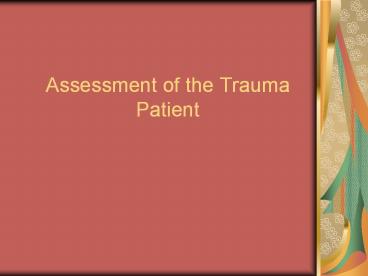Assessment of the Trauma Patient PowerPoint PPT Presentation
1 / 24
Title: Assessment of the Trauma Patient
1
Assessment of the Trauma Patient
2
- Focused History and Physical Exam for the Trama
Patient
3
- No significant mechanism of injury
- Focus assessment on just the areas of injury or
compliant. - Includes
- Physical Exam
- VS
- SAMPLE
4
- D C A P B T L S
- e o b u u e a w
- f n r n r n c e
- o t a c n d e l
- m u s t s e r l
- i s I u r a i
- t I o r n t n
- i o n e e I g
- e n s s s o
- s s s n
- s
5
- Apply a cervical collar
- during the rapid trauma assessment
6
- Trauma patient with a significant mechanism of
injury - Remember with children same type of injury may
take less force. - Continue spinal immobilization
- Reconsider transport decision
- Reassess MS
7
- Perform a Rapid Trauma Assessment
- Inspect
- Palpate
- Auscultate
- Smell
- From head-to-toe
8
- Jugular vein distension
- Paradoxical motion
- Flail chest
- Crepitation
- Subcutaneous Emphysema
- Pulsating mass
- Pelvis- Priapism
9
- PMS PMS
- PMS PMS
- PMS
- PMS PMS PMS
- PMS
- PMS PMS PMS
- PMS PMS
10
- Reconsider mechanism of injury
- Determine chief complaint
- Perform a focused physical exam
11
- Expose
12
- Mechanism of Injury
- Index of suspicion
- Law of inertia A object in motion stays in
motion until acted upon by another force - Three collisions First vehicle strikes
something - Second Victim strikes something
on impact
13
- Third collision organs strike
14
- Examples
- Head-on collision
- Up and over injury
- up and over the steering wheel
- Down and under injury
- down and under the steering wheel
15
- Rear-end collision
- Head and neck injury
- Side impact collision
- Skeletal and internal injuries
- Rollover
- Possibility of ejection
- Rotational Impact
- Observe damage to the windshield, steering
wheel, dash and pedals
16
- Motorcycles and ATVs
- Helmet?
- Suspect any and all types of injuries
17
- Falls
- Height of fall
- three times patient height is severe
- Surface they landed on
18
- Penetrating Trauma
- Shooting stabbing
- Velocity Speed of the object
- Low velocity
- Stabbing
- Injury usually isolated to area penetrated
- multiple wounds
- damage to internal organs
19
- Medium-velocity
- Handguns and shotguns
- Arrows
- High velocity
- High powered rifles
- Assault rifles
20
- Bullets cause damage in two ways
- Damage directly from the bullet itself
- Cavitation
- pressure wave
21
- Blunt Force Trauma
- maintain a high index of suspicion
22
Assessment of the Medical Patient
- Responsive
- Four parts
- History of present illness
- Focused physical exam
- OPQRST
- SAMPLE
- Baseline VS
- Prior history
- DCAPBTLS
23
- Unresponsive
- Patient history from family, bystanders etc.
- Rapid assessment
- Abd distension, firmness, rigidity
- Pelvis Incontinence of urine, feces
- ID bracelets
- Baseline VS
- Consider need for ALS
- History of present illness and SAMPLE
24
- History of present illness and SAMPLE
- Patients name
- What happened
- what did family/bystander see
- Did patient complain of anything prior
- Know illness
- Medications

